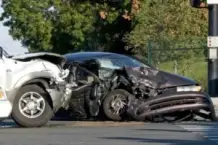
In some driver’s education courses, instructors emphasize that students need to “choose their accident.” This simply means that if a collision is inevitable but you have time to respond to a hazard ahead, you should choose the action that will result in the least amount of damage possible.
For example, if there is a deer up ahead but you cannot slow down in time, you must choose between swerving into oncoming traffic, hitting the deer, or swerving off the road and into the brush. If there are merely bushes and tall grass lining the side of the road, the third option may be the safest choice.

Laborde Earles injury was great for me they took care of me very fast and professional. If for any reason I need legal help they will be who I use.
ClientIf the road is lined with tall, sturdy trees, though, and you are driving an SUV or pickup truck that is fairly high off the ground, you may be less likely to sustain injuries by simply hitting the deer than by careering off the road. Regardless of the particular factors at play, which might include the size of the deer, the size of the vehicle, and the density of the surrounding trees, the one action that motorists should never take is swerving into oncoming traffic.
Head-on collisions are the most dangerous kind of accidents. According to the Insurance Institute for Highway Safety, they were responsible for 54 percent of all traffic fatalities in 2015.
The second deadliest kind of collision was side-impact crashes, or T-bone collisions. They accounted for 25 percent of all traffic deaths that same year.
Since head-on collisions typically come out of nowhere, they are essentially unavoidable; however, T-bone crashes almost always happen at intersections, which means there are steps motorists can take to reduce the risk of getting into one when crossing lines of traffic.
I thank God for Digger & David. I don’t know what we would have done if it hadn’t have been for them.
Rick Smith | ClientIf you were hurt in a devastating collision that was not your fault, contact Laborde Earles Injury Lawyers. Our personal injury team is proud to represent accident victims throughout Alexandria and all of Louisiana every single day. Call 800-522-6733 to schedule a free case evaluation with an auto accident attorney in Alexandria.
Read on to learn how you can reduce the risk of getting into a T-bone collision when approaching an intersection:
- Eliminate Distractions
The reassurance from Digger and his staff gave me that renewed hope that it’s going to be okay down the road.
ClientA lot of motorists check their phone or turn to some other distraction when waiting at a light. It may seem harmless since you are not actually moving, but taking your eyes off the road at all—even when stopped—can prevent you from spotting subtle road hazards that arise and will need your attention once you start moving again. As a general rule of thumb, you should eliminate distractions for the entire duration of your trip.
- Obey All Traffic Markers
They treated us like no other people would. Whenever we needed something they were there for us. I put my trust in them and I don’t regret it.
ClientCome to a complete stop at stop signs, slow down as you approach yellow lights, and stop entirely for flashing red lights until it is safe to proceed. You should also make it a point to follow all traffic laws regarding right of way; however, do not assume that the other motorists around you will do the same.
- Wait for a Clear View
If stopped traffic is obstructing your view at an intersection, wait for it to clear before proceeding. Never turn or cross traffic unless you have visual confirmation that it is safe to do so.
If you were hurt in a T-bone collision because someone else failed to follow the tips above, contact Laborde Earles Injury Lawyers. Our legal team has 350 years of combined experience filing successful personal injury claims for accident victims. Call 800-522-6733 to schedule a free consultation with an auto accident lawyer in Alexandria.





